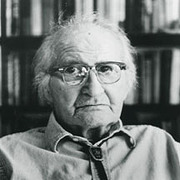Henry Roth (1) (1906–1995)
Autor(a) de Call It Sleep
Para outros autores com o nome Henry Roth, veja a página de desambiguação.
Séries
Obras de Henry Roth
Signatures: Work in Progress, Number Two 1 exemplar(es)
Call It Sleep[CALL IT SLEEP][Paperback] 1 exemplar(es)
Associated Works
Who's Writing This? Notations on the Authorial I, with Self-Portraits {not Antæus} (1995) — Contribuinte — 72 cópias
Etiquetado
Conhecimento Comum
- Data de nascimento
- 1906-02-08
- Data de falecimento
- 1995-10-13
- Sexo
- male
- Nacionalidade
- USA
- Local de nascimento
- Tysmenitz, Galicia, Austro-Hungary
- Local de falecimento
- Albuquerque, New Mexico, United States
- Locais de residência
- New York, New York, USA
Albuquerque, New Mexico, USA
Tysmenica, Galicia, Austria (birth | now Ukraine) - Educação
- City College of New York
- Ocupação
- teacher
novelist
short story writer
machinist - Premiações
- American Academy of Arts and Letters Academy Award (Literature, 1965)
- Pequena biografia
- Henry Roth was born to a Jewish family in Tysmenitz, Galicia, in the Austro-Hungarian Empire (present-day Ukraine). When he was a small child, he emigrated with his family to the USA, setting in New York City. In 1928, he graduated from City College of New York and moved in with Eda Lou Walton, a poet and English literature instructor at New York University. With her support and encouragement, he wrote his first novel, Call It Sleep. It was published in 1934 to mostly good reviews, but then forgotten; the book underwent a critical reappraisal 30 years later, after it was republished in paperback and became an instant bestseller. Call It Sleep is now considered a masterpiece and a classic Depression-era work. Roth began a second novel, but was afflicted by a deep writer's block that lasted for decades. In 1938, at the artists' colony Yaddo in Saratoga Springs, New York, he met Muriel Parker, a pianist and composer; the couple married the following year and had two sons. The family moved several times as Roth took jobs as varied as machinist, woodsman, schoolteacher, psychiatric attendant in a state mental hospital, raising waterfowl, and Latin and math tutor. In 1968, he and his wife moved to Albuquerque, New Mexico. There Roth collaborated with his friend and Italian translator, Mario Materassi, on putting together a collection of short stories and essays, Shifting Landscape: A Composite, 1925–87, published in 1987. Eventually, Roth completed two of the next installments in the projected six-volume work he had been trying to write for 60 years. The first, Mercy of a Rude Stream, was published in 1994; A Diving Rock on the Hudson appeared in 1995, the year of his death. An American Type, based on an unpublished manuscript edited by Willing Davidson, appeared in print in 2010.
Membros
Resenhas
Listas
1930s (1)
Prêmios
You May Also Like
Associated Authors
Estatísticas
- Obras
- 11
- Also by
- 7
- Membros
- 3,073
- Popularidade
- #8,309
- Avaliação
- 3.8
- Resenhas
- 64
- ISBNs
- 122
- Idiomas
- 10
- Favorito
- 8
























This story by Henry Roth, published in 1934, out of print for a number of years was reprinted in 1960, is the story of the immigrant experience, specifically the Jewish immigrant. It is most likely set in the time period of the early 20th century. 1907 brought the greatest number of immigrants through Ellis Island into New York City where they mostly stayed and turned the streets into slums.
The family consists of David Schearl, a 6 y/o boy, his mother Genya and his father Albert. Other characters include; Bertha, sister to Genya, Reb Yidel, Rabbi teaching David who is an exceptional student, Leo a Catholic boy.
While this is the story of the immigrant experience it is more than that. It is also the story of a family and family secrets. It is a story of language and dialects. There is Yiddish, Irish, Polish, English, Hebrew. It is a story of culture; Jewish, Yiddish, Catholic, slum culture. It also looks at feminist experience. The patriarchal society, the consumerism of American Society.
Themes include the mother son bond, oedipal rivals, parricide, "purity".
David becomes fixated on a passage from Isaiah where Isaiah's unclean lips are cleansed with a burning coal. David sees a "white light" one day, he decides that this is what is being referred to in Isaiah. So there is the theme of purity. David resists sexual explorations that other boys seek. His aunts step daughters are another example.
There is much to glean in the novel. It is a great example of the Jewish novel, I think. I would recommend this to anyone who likes to read about Jewish experience but also the immigrant experience.… (mais)